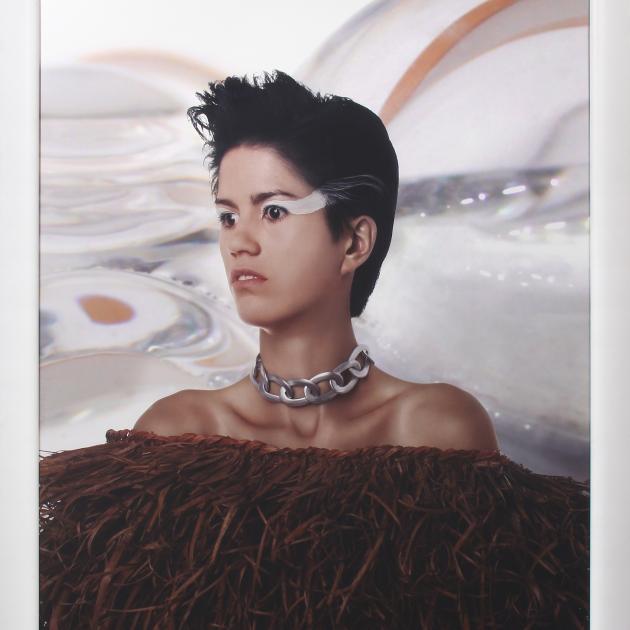In this week's Art Seen, Robyn Maree Pickens looks at works from Lisa Reihana, an exhibition from Reed Gallery, and Douglas Gordon.

Currently on display at Milford Galleries Dunedin is an impressive exhibition of large photographic works by multimedia artist Lisa Reihana (Ngapuhi).
Titled ''3 x 4'', the exhibition draws on three bodies of work: the acclaimed ''Digital Marae'' (2007), ''Nga Hau e Wha'' (2009) and ''Pelt'' (2010).
Although selected from three distinct bodies of work, ''3 x 4'' coheres conceptually, aesthetically and formally. What unites this exhibition, and indeed Reihana's oeuvre, is her deliberate construction of worlds that are uncanny; that hover between the familiar and the unfamiliar.
For example, in East Wind, from ''Nga Hau e Wha'', a young woman with a contemporary hairstyle and bare shoulders wears a fibre cloak, a metal chain link necklace, and white retro-futuristic eye makeup that drifts into her hair.
She is simultaneously the present, the past and the future. Behind her is a digitally constructed world reminiscent of eddying water and slender arcs that could be hills.
In works such as these, Reihana's purposively ambiguous worlds enable identities (cultural, Maori, gender, sexual) to be reimagined and reconfigured. A hallmark of these worlds is inclusivity.
Lisa Reihana is a finalist in the 2016 Walters Prize, and she will represent New Zealand at the 2017 Venice Biennale with a panoramic video installation In Pursuit of Venus [infected].

In late July, Otago Daily Times journalist John Gibb interviewed Reed Rare Books and Special Collections librarian Julian Smith on the exhibition of theatrical ephemera, then newly opened, in the Reed Gallery at Dunedin Public Library.
This exhibition, titled ''Flits Across the Stage'' is well worth a visit for reasons aesthetic and historical, and for some, nostalgic.
The ephemera on display consist entirely of theatrical programmes, which librarian and curator Julian Smith has organised into genres including Light Opera, Rodgers and Hammerstein, Military Entertainment Troupes and Grand Opera.
Some of the earliest programmes dating back to the 1880s are too fragile to exhibit, but have been scanned and can be viewed as a slideshow on a monitor. The majority of the 100 programmes, however, are displayed in beautifully crafted vitrines according to genre.
These programmes, which date from the early 1900s to the early 1970s, enable the visitor to take in a broad sweep of typological and graphic design styles and periods.
In the Rodgers and Hammerstein vitrine, the programme for Oklahoma! (1950) captures the pastel exuberance and stylistic conventions of 1950s design.
By contrast, the wartime programmes are pared back and economical in both design and presentation. This is the first time this rare collection has been exhibited.

Scottish artist Douglas Gordon won the prestigious Turner Prize in 1996 and represented Britain at the Venice Biennale the following year.
Now showing at the Dunedin Public Art Gallery is an elephant-sized video installation that features, naturally enough, a giant Indian elephant called Minnie, who performs tricks for an off-screen trainer.
''Play Dead; Real Time'' was staged, filmed, and subsequently exhibited at the Gagosian Gallery, New York, in 2003. It is a three-channel video installation projected on to two large screens that are positioned diagonally so as to almost produce an inverted ''V''.
The two large screens are positioned centrally which enables the visitor to walk around, while the offset dovetailing gives the visitor the opportunity to switch between the front and rear projection.
This split view lends an unexpected three-dimensional aspect to what is, overall, an intensely immersive and oddly touching encounter with an elephant stripped of its natural habitat.
Minnie performs a series of repeated actions: she walks around, lies down to play dead and gets up. Gordon transforms these actions into an engaging experience; due in part to the subject, but particularly to the rotating camera, multiple perspectives, and of the relationship between the screens, which complement each other with only occasional moments of near synchronicity.
-By Robyn Maree Pickens
Comments
The East Wind Story.
If blowing inshore on the east coast, buffets and brings rain.
If from the mountains to offshore west coast, you can walk headlands with ease at low tide.
Blimey, that's handy.
She's the Spirit of Otaki. Watch it.












